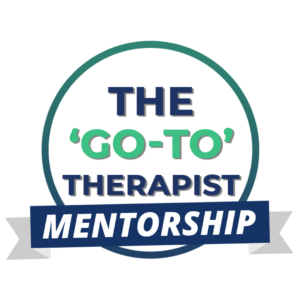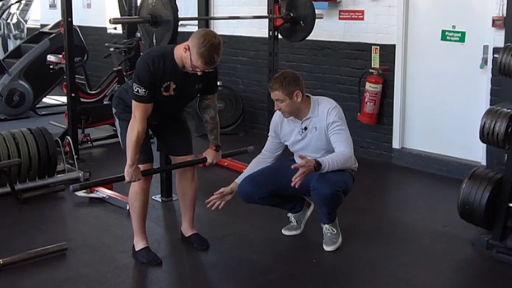Building Resilience Under External Loads And Increased Stress
Throughout the ‘Go-To’ Therapist method we have been building on each pillar.
Through subjective and objective assessments, designing treatment plans, applying hands-on treatment, progressing/regressing graded exposure rehab, higher-level rehab, whilst always using communication to engage with the patient.
It has been a long journey. The final pillar in the ‘Go-To’ Therapist method is to utilise the ability to generate tension in these muscles in all directions and build strength.
In this stage, you will ensure your patient can tolerate the load and still move with good movement variability and weight distribution through the hand or foot.
I don’t agree with the notion that just getting people strong is enough. I have worked for 10+ years with strong athletes that were in pain.
Therefore, this pillar happens after the nervous system is happy to generate tension in all directions. We can still achieve a task of heavy deadlifting weights but the adductor magnus, for example, may be creating additional torque if the lateral hip tissues are still not proficient and are perceived as a threat.
So, just like every other pillar in this process, the ‘Go-To’ Therapist’s patients earn the right to be at this stage at the appropriate time. The athlete/patient will get even stronger when he/she has plenty of movement options and the actual ability to produce force through as many motor units as possible.
At this stage, from my experience, you will see a significant increase in strength and power capabilities once the right has been earned to be at this level.
The patient does not necessarily need to wait until progressing to pillar 6 to start additional loading and, indeed, depending on the patient’s needs, will actually start external loading in pillar 5 if that is what is needed, specific to that patient.
This step is more concerned with building general resilience to various loads placed on the body both mentally and physically.
The ‘Go-To’ Therapist will achieve good movement variability and physical resilience by ensuring there is good weight distribution through the whole foot and hand when lifting external loads.
One of the biggest mistakes I see being made by strength and conditioning coaches in this day and age is an obsession with everything having to be pushed through the heels.
The athlete starts on the heels and finishes on the heels. This is one sure way to ensure decreased movement variability, coordination and an inability to react to perturbatory loads from different angles.
The ‘Go-To’ Therapist will logically think about it and look at Olympic weightlifters and the gait cycle, and see that during times of hip extension, when we need good coordination to manage big loads, we need the weight distribution to be going towards the midfoot and forefoot, not stuck on the heels.
I personally believe this cue to push through the heels is ingraining and reinforcing poor coordination patterns and making athletes less efficient in the long run. The ‘Go-To’ Therapist wants their patients to be able to have good movement variability and manage their weight as it travels towards the heel when the hip flexes and travels towards the mid- to forefoot when the hip extends.
Another big goal for the ‘Go-To’ Therapist is to help build mental resilience for the patient. It is, in my opinion, important to expose the patient to environments or situations that will bring them into the sympathetic nervous system dominance.
This is inevitable in everyday life.
What is most important for the patient is to be able to get back out of sympathetic dominance again and into the parasympathetic or ‘rest and digest’ system.
These scenarios can be stressful situations or environments such as at home or work or at training for the athlete. We need the patient to be able to utilise their sympathetic nervous system but then when the stressor is removed, revert back into their parasympathetic nervous system and recover and regenerate.
For example, this type of resilience training would be appropriate for those patients with persistent back pain before going to sleep to ensure they are actually in rest and digest before sleeping and also first thing in the morning when waking.
Integrating this type of intervention can have massive effects on overall mood, mindset and quality of life from my personal observation with patients. I’m sure you too have witnessed the power of a good night’s sleep on mood, movement and mindset.
And that is the complete step-by-step system that I’ve been using successfully over the last few years with athletes or private practice patients who come to me, who have on paper done everything ‘right’ and have been under the care of some top class physios but may just have skipped a pillar or two in their plan.
The most overlooked or ‘missed’ pillar of our 8 pillars is pillar 1 – not understanding the patient’s story thoroughly – which makes it almost impossible to make sense of the objective assessment and consequent pillars thereafter.
Then, after this, I believe it would be not understanding WHY the REACTIONS and SYMPTOMS have happened in the first place. So while most therapists are focusing their time on the symptoms, it only accounts for 20% of the ‘Go-To’ therapist’s time and 80% of their time is spent focusing on the tissues that are not doing enough in the first place that caused these reactions.
Once you have identified these directions of force, then it will just be slight tweaks in your exercises to stimulate specific directions of loading that are currently being avoided. You will usually notice quick changes and then it is just a case of giving the patient the right stimulus at the right time in the graded exposure programme.
At all times, ensure your patient has clarity on the problem and the solution (graded exposure rehab programme) which is meaningful to their situation. The outcomes will add value to their life and you will never have a problem with patient motivation, adherence or a patient dropping off.
Remember, your patient will usually drop off when there is a perception of a lack of progress or when no more progress is being made. The step-by-step graded exposure programme combined with an effective explanation will solve this problem for the ‘Go-To’ Therapist.
In the next part, we will dissect the essential components to ensuring you become the ‘Go-To’ Therapist in your town, getting consistently long-lasting results and helping people who have failed traditional approaches and who travel miles to see you.


